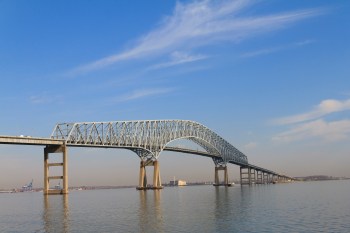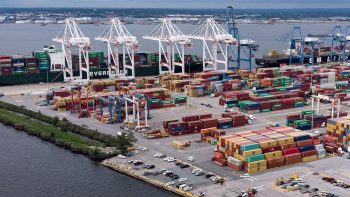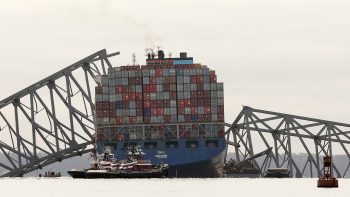Baltimore sewers: time bombs buried under the streets
First, a warning: this story is a little icky.
I’m in Gwynn’s Run, a stream in Baltimore, with David Flores of the nonprofit Blue Water Baltimore. He’s giving me what he calls his sewer tour. City pipes are so old and cracked, rainwater gets in. Sewers fill up, and the contents spit out manhole covers and into streams.
David Flores of Blue Water Baltimore, showing and explaining sewer system overflows in Baltimore. (Scott Tong, Marketplace)
That sewage eventually dumps directly into Baltimore’s harbor. Eww. Chances are, your city has the same issues. You’ve heard about bridges collapsing? This is the invisible infrastructure crisis below ground.
Baltimore’s story goes back a century. It starts with a putrid harbor, described by the Washington Post as “a 2,000 horsepower smell that lays Limburger cheese in the shade.”
“The Baltimore harbor was the toilet of the city,” says Chris Boone, sustainability dean at Arizona State and author of a paper on Baltimore’s sewer history. “Everything would flow down into the harbor. So everything that was coming from overflowing cesspools and privies, everything that was coming from the streets, ran into the harbor.”
The thing was, Baltimore had no money to build a sewer system. Until the Great Baltimore Fire.
Church of the Messiah in flames during 1904 Great Baltimore Fire.
In 1904, one of the worst fires in American urban history torched 1,500 buildings downtown. Crisis created opportunity.
“That fire, what it did was similar to the Chicago fire of 1871,” Boone says. “I think it gave the city and also residents a chance to re-think ‘how do we regrow the city in a way that was even greater than before?’”
Here more from Boone below:
The resources came. The city put up money, as did the state of Maryland. Voters approved a bond issuance. And Baltimore built a state-of-the-art sewer system completed exactly 100 years ago. Out went the stink and in came more than 1,000 miles of pipes. Typhoid was eradicated. Politicians snapped this picture to commemorate the event.
Baltimore leaders celebrate a new sewer system by driving their cars inside.
To understand this progress, you have to step inside the city’s sewer waste-water treatment plant. To simplify, raw sewage floats past an initial set of bars to screen out anything from two-by-fours to rats and mice. Then – euphemism alert — comes sludge settling amid solids removal. The plant takes out chemicals and nitrogen, then bleaches and de-chlorinates water before sending it out to the river.
If you’re wondering, yes, it stinks. But it’s also amazing to see what you get for your sewer bill.
Back River Wastewater Plant, Baltimore.
That is, when the pipes work as intended. A century later, it’s like inheriting your great-grandfather’s car. This is what the pros call the water infrastructure “replacement age.” And by one estimate, the national bill will cost $1 trillion.
“It’s like a time bomb,” Baltimore’s public works director, Rudy Chow, says. “This old infrastructure, we know it’s going to fail. The question is where and when.”
Hear more from Chow below:
Baltimore has embarked on a $1.5 billion program to replace and rebuild. Jackhammers throughout the city dig up streets and replace pipes, the oldest of which are made of wood and terra cotta.
Sewer main replacement, downtown Baltimore.
The federal government is imposing clean water deadlines. It all costs money Baltimore doesn’t have. Federal grants for this kind of work dried up long ago. The city has lost 300,000 taxpayers and rate payers to urban flight in a generation.
“There was no anticipation of deindustrialization,” Boone says. “No anticipation of riots in the 1960s or the crack cocaine epidemic of the 1980s. All these things. And then the suburbanization of individuals looking for better schools. None of that was in the cards.”
So the city has no choice but to raise rates. A typical quarterly combined water and sewage bill has gone from $62 in 2000 to $201 today. Over the century, the city never charged high enough rates to maintain the system. And now the bill is due.
“Politicians always complain, ‘We can’t raise prices because we’ll get political opposition,’” says economist David Zetland, author of “Living with Water Scarcity.” “The most common problem with the water system is that they’re not taking enough money in to pay for the system repair and maintenance that matters over a 50-year cycle.”
Hear more from Zetland below:
Chow says future rate hikes are “inevitable.” The city’s plan is to spend more of the public’s money on preventive replacement, and less on emergencies. Right now it’s the other way around. Baltimore plans to put itself on a sustainable pace to replace a water main every 100 years.
But change will not come easily. Residents like Danielle Miles of a northwest section of Baltimore complain they have not benefited from any changes. In fact, Miles says sewer disasters come every time a big rain hits. The most recent came in the spring of 2014.
“I noticed the sanitary sewer manhole had water coming up” Miles says. “And at that point in time I knew that my basement was flooded.”
Miles walked in, down to the basement. And she saw.
“Raw sewage, all throughout. It was maybe about, what’s this, a foot? One step. And it was just rising.”
One street over, an upright freezer was floating, upside down, in the home of Anita Moore and her parents. Wedding albums were destroyed.
“My parents have been married for 58 years,” Moore says. “You can’t replace any of those photos. And all our baby pictures. All gone.”
Now, the rainy season is coming again, and Moore says she has no idea if anything is fixed. She and Miles both say they’ve heard nothing from the city. Baltimore’s public works department says pipes in the neighborhood have been cleaned, and that it’s a “long-term strategy” to address the situation. A spokesman says in some cases what floods residents’ basements is not raw sewage but storm water.
What everyone agrees on is that this is the price of a century of infrastructure neglect. In this city, it took a mighty fire to galvanize the public and begin a massive infrastructure build. Now these pipes are nearing the end of their engineered lives.
What will it take to rebuild and replace them nationally? Boone is afraid it may take another crisis – on the order of a city burning down – to attract public attention once again.
Correction: A previous version of this story originally misidentified David Flores. The text has been corrected.
There’s a lot happening in the world. Through it all, Marketplace is here for you.
You rely on Marketplace to break down the world’s events and tell you how it affects you in a fact-based, approachable way. We rely on your financial support to keep making that possible.
Your donation today powers the independent journalism that you rely on. For just $5/month, you can help sustain Marketplace so we can keep reporting on the things that matter to you.


















